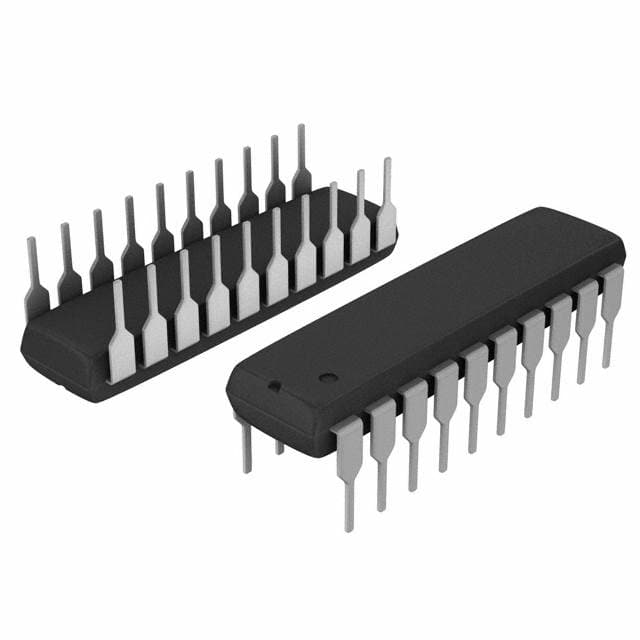Consulte las especificaciones para obtener detalles del producto.

AT89C1051U-12PC
Product Overview
Category
The AT89C1051U-12PC belongs to the category of microcontrollers.
Use
This microcontroller is commonly used in various electronic applications that require embedded control and processing capabilities.
Characteristics
- High-performance 8-bit CMOS microcontroller
- Low-power consumption
- Wide operating voltage range
- Integrated flash memory for program storage
- Multiple I/O ports for interfacing with external devices
Package
The AT89C1051U-12PC is available in a 20-pin plastic dual inline package (PDIP).
Essence
The essence of this microcontroller lies in its ability to provide efficient and reliable control and processing capabilities in a compact and low-power package.
Packaging/Quantity
The AT89C1051U-12PC is typically packaged in reels or tubes, with a quantity of 100 units per package.
Specifications
- Architecture: 8-bit
- CPU Speed: 12 MHz
- Program Memory Size: 1 KB
- RAM Size: 64 bytes
- Number of I/O Pins: 15
- Operating Voltage Range: 2.7V to 6V
- Operating Temperature Range: -40°C to +85°C
- Data Sheet: Link to Data Sheet
Detailed Pin Configuration
The AT89C1051U-12PC has a total of 20 pins, each serving a specific purpose. The pin configuration is as follows:
- P1.0 (Pin 1) - Port 1, Bit 0
- P1.1 (Pin 2) - Port 1, Bit 1
- P1.2 (Pin 3) - Port 1, Bit 2
- P1.3 (Pin 4) - Port 1, Bit 3
- P1.4 (Pin 5) - Port 1, Bit 4
- P1.5 (Pin 6) - Port 1, Bit 5
- P1.6 (Pin 7) - Port 1, Bit 6
- P1.7 (Pin 8) - Port 1, Bit 7
- RST (Pin 9) - Reset Pin
- VCC (Pin 10) - Supply Voltage
- P3.0 (Pin 11) - Port 3, Bit 0
- P3.1 (Pin 12) - Port 3, Bit 1
- P3.2 (Pin 13) - Port 3, Bit 2
- P3.3 (Pin 14) - Port 3, Bit 3
- P3.4 (Pin 15) - Port 3, Bit 4
- P3.5 (Pin 16) - Port 3, Bit 5
- P3.6 (Pin 17) - Port 3, Bit 6
- P3.7 (Pin 18) - Port 3, Bit 7
- XTAL1 (Pin 19) - Crystal Oscillator Input
- XTAL2 (Pin 20) - Crystal Oscillator Output
Functional Features
The AT89C1051U-12PC offers several functional features that enhance its usability and performance:
- Flash Memory: The integrated flash memory allows for easy reprogramming of the microcontroller, enabling flexibility in application development.
- I/O Ports: The multiple I/O ports provide the ability to interface with external devices, expanding the microcontroller's capabilities.
- Low-Power Consumption: The microcontroller is designed to operate efficiently with low power consumption, making it suitable for battery-powered applications.
- Wide Operating Voltage Range: With an operating voltage range of 2.7V to 6V, the microcontroller can be used in various electronic systems.
Advantages and Disadvantages
Advantages
- Compact size and low-power consumption make it suitable for portable and battery-powered devices.
- Integrated flash memory allows for easy reprogramming and flexibility in application development.
- Multiple I/O ports provide versatility in interfacing with external devices.
Disadvantages
- Limited program memory size (1 KB) may restrict the complexity of applications that can be implemented.
- Limited RAM size (64 bytes) may impose constraints on data storage and manipulation.
Working Principles
The AT89C1051U-12PC operates based on the principles of a typical microcontroller. It executes instructions stored in its flash memory, processes data using its CPU, and communicates with external devices through its I/O ports. The microcontroller follows a fetch-decode-execute cycle to perform tasks as per
Enumere 10 preguntas y respuestas comunes relacionadas con la aplicación de AT89C1051U-12PC en soluciones técnicas
Sure! Here are 10 common questions and answers related to the application of AT89C1051U-12PC in technical solutions:
Q1: What is AT89C1051U-12PC? A1: AT89C1051U-12PC is a microcontroller chip manufactured by Atmel. It is an 8-bit microcontroller with 1KB of Flash memory, 64 bytes of RAM, and various peripherals.
Q2: What are the main features of AT89C1051U-12PC? A2: The main features of AT89C1051U-12PC include 12MHz operating frequency, 15 programmable I/O lines, 2 16-bit timer/counters, 4-channel 10-bit ADC, UART, and SPI interface.
Q3: What are some typical applications of AT89C1051U-12PC? A3: AT89C1051U-12PC is commonly used in applications such as industrial control systems, home automation, robotics, sensor interfacing, and small embedded systems.
Q4: How do I program AT89C1051U-12PC? A4: AT89C1051U-12PC can be programmed using a variety of programming tools, such as an In-System Programmer (ISP) or a parallel programmer. The programming process involves loading the compiled code into the microcontroller's Flash memory.
Q5: Can I use C language to program AT89C1051U-12PC? A5: Yes, you can use C language to program AT89C1051U-12PC. There are several compilers available that support this microcontroller, such as Keil C51 and SDCC.
Q6: How do I interface external devices with AT89C1051U-12PC? A6: AT89C1051U-12PC has multiple I/O pins that can be used to interface with external devices. You can connect sensors, actuators, displays, and other peripherals to these pins based on your application requirements.
Q7: What is the maximum operating voltage for AT89C1051U-12PC? A7: The maximum operating voltage for AT89C1051U-12PC is 5.5V. It is important to ensure that the voltage supplied to the microcontroller does not exceed this limit.
Q8: Can I use AT89C1051U-12PC in battery-powered applications? A8: Yes, AT89C1051U-12PC can be used in battery-powered applications. Its low power consumption makes it suitable for portable and low-energy devices.
Q9: Is AT89C1051U-12PC suitable for real-time applications? A9: AT89C1051U-12PC can be used in real-time applications, but its capabilities may be limited due to its relatively low processing speed and memory size. It is recommended to assess the specific requirements of your real-time application before choosing this microcontroller.
Q10: Are there any development boards available for AT89C1051U-12PC? A10: While there are no specific development boards dedicated to AT89C1051U-12PC, you can create your own development board using a breadboard or design a custom PCB to accommodate the microcontroller and necessary components.

